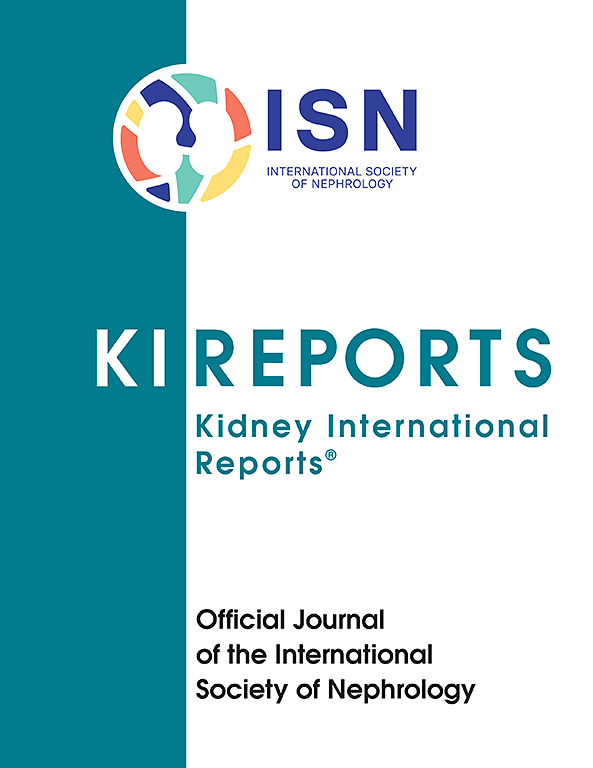Nephrotic Syndrome Thromboprophylaxis With Direct Oral Anticoagulants or Vitamin K Antagonists
IF 5.7
2区 医学
Q1 UROLOGY & NEPHROLOGY
引用次数: 0
Abstract
Introduction
Nephrotic syndrome (NS) is a pathological state of the glomerular filtration barrier associated with an increased venous and arterial thrombotic risk. Current guidelines suggest heparin-based or vitamin K antagonist (VKA) regimens for thromboprophylaxis in such patients. Although widely prescribed for other indications, direct oral anticoagulants (DOACs) are not recommended in NS because of limited pharmacological and safety reports. This study aimed to compare DOACs and VKAs for thromboprophylaxis in NS, specifically regarding thrombotic events (TEs) and bleeding events (BEs).
Methods
We conducted a retrospective monocentric analysis of recorded NS episodes that required prophylactic anticoagulation between January 2006 and December 2023. We included 133 NS episodes of which 51 were treated with DOACs and 82 with VKAs. The primary endpoint was a composite endpoint, including thrombosis occurrence and major or clinically significant BEs during thromboprophylaxis. The secondary endpoints consisted of relevant features potentially involved when each primary endpoint was considered independently.
Results
Patient characteristics, underlying NS etiology, personal thrombotic and bleeding risk factors, and biological parameters were globally similar in both groups. The primary endpoint appeared similar in both groups (P = 0.481). The secondary endpoints were mostly hypothesis-generating because of the low TE (n = 2) and BE (n = 7) occurrences.
Conclusion
This study provides reassuring clinical data on DOAC use in NS thromboprophylaxis compared with VKAs, the recommended therapy, and calls for confirmation in randomized controlled trials (RCTs) and larger pharmacological studies.

直接口服抗凝剂或维生素K拮抗剂预防肾病综合征血栓形成
肾病综合征(NS)是肾小球滤过屏障的一种病理状态,与静脉和动脉血栓形成风险增加有关。目前的指南建议这类患者采用基于肝素或维生素K拮抗剂(VKA)的方案预防血栓形成。尽管广泛用于其他适应症,但由于有限的药理学和安全性报告,不建议在NS中使用直接口服抗凝剂(DOACs)。本研究旨在比较DOACs和vka对NS血栓预防的作用,特别是血栓事件(TEs)和出血事件(BEs)。方法对2006年1月至2023年12月期间需要预防性抗凝治疗的NS发作进行回顾性单中心分析。我们纳入了133例NS发作,其中51例采用doac治疗,82例采用vka治疗。主要终点是一个复合终点,包括血栓发生和血栓预防期间主要或临床显著的BEs。次要终点由独立考虑每个主要终点时可能涉及的相关特征组成。结果两组患者的特征、潜在的NS病因、个人血栓和出血危险因素以及生物学参数在全球范围内相似。两组的主要终点相似(P = 0.481)。次要终点主要是假设产生,因为低TE (n = 2)和BE (n = 7)发生率。结论:本研究提供了与vka(推荐疗法)相比DOAC用于NS血栓预防的可靠临床数据,并需要在随机对照试验(RCTs)和更大规模的药理学研究中得到证实。
本文章由计算机程序翻译,如有差异,请以英文原文为准。
求助全文
约1分钟内获得全文
求助全文
来源期刊

Kidney International Reports
Medicine-Nephrology
CiteScore
7.70
自引率
3.30%
发文量
1578
审稿时长
8 weeks
期刊介绍:
Kidney International Reports, an official journal of the International Society of Nephrology, is a peer-reviewed, open access journal devoted to the publication of leading research and developments related to kidney disease. With the primary aim of contributing to improved care of patients with kidney disease, the journal will publish original clinical and select translational articles and educational content related to the pathogenesis, evaluation and management of acute and chronic kidney disease, end stage renal disease (including transplantation), acid-base, fluid and electrolyte disturbances and hypertension. Of particular interest are submissions related to clinical trials, epidemiology, systematic reviews (including meta-analyses) and outcomes research. The journal will also provide a platform for wider dissemination of national and regional guidelines as well as consensus meeting reports.
 求助内容:
求助内容: 应助结果提醒方式:
应助结果提醒方式:


